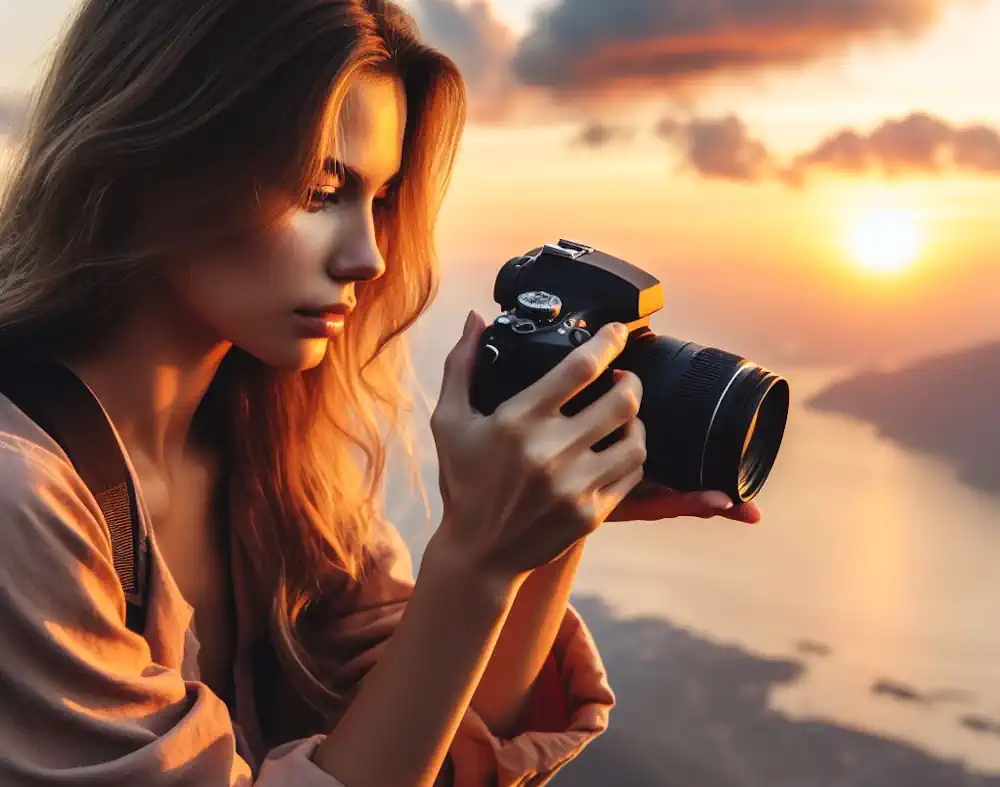Do you want to take stunning portrait photos with your digital camera? Look no further! In this article, you will find 10 essential tips that will help you capture amazing portraits. From utilizing natural light to experimenting with different angles and compositions, these tips will elevate your photography skills and ensure that your portraits stand out. Whether you are a beginner or an experienced photographer, these tips will inspire you and help you create captivating portrait photos with your digital camera. Get ready to unleash your creativity and take your photography to the next level!
Choosing the Right Camera
When it comes to capturing stunning portrait photos, the first step is to choose the right camera. There are various types of cameras available in the market, such as DSLR, mirrorless, and point-and-shoot cameras. Each type has advantages and disadvantages, so it’s important to consider your needs and preferences.
DSLR cameras are popular among professional photographers due to their versatility and ability to interchange lenses. They offer manual control over settings, allowing you to have full creative control. On the other hand, mirrorless cameras are compact and lightweight, making them a great choice for travel and street photography. Point-and-shoot cameras are more affordable and simple to use, perfect for beginners or casual photographers.
Along with the type of camera, it is crucial to check the resolution and sensor size. Higher-resolution cameras produce sharper and more detailed images, which is essential when capturing portraits. Additionally, a larger sensor size allows for better low-light performance and a higher dynamic range. So, considering these factors will help you make an informed decision when choosing the perfect camera for your portrait photography.
Selecting the Ideal Lens
Once you have chosen the right camera, the next step is to select the ideal lens. The lens you use can have a significant impact on your portrait photos, as it determines the perspective, depth of field, and overall image quality. Understanding focal length is key to selecting the right lens for your portraits.
Focal length refers to the distance between the lens and the camera’s sensor. It determines the magnification and the field of view of the lens. Lenses with shorter focal lengths, such as wide-angle lenses, are great for capturing environmental portraits or group shots. On the other hand, lenses with longer focal lengths, like telephoto lenses, are perfect for close-up shots, capturing details, and creating a shallow depth of field effect.
Experimenting with different types of lenses is also essential. Try using prime lenses with a fixed focal length, as they often offer better image quality and wider aperture options. Zoom lenses, on the other hand, provide flexibility in terms of focal length but may have a narrower maximum aperture. By exploring different lenses, you can discover the unique characteristics they bring to your portrait photography.
Finding the Perfect Lighting
Lighting plays a crucial role in portrait photography. It can enhance the mood, highlight features, and bring your subject to life. When it comes to lighting, there are two main types to consider: natural light and artificial lighting.
Utilizing natural light can create a beautiful, soft, and natural-looking portrait. The best time to capture portraits with natural light is during golden hour, which occurs shortly after sunrise or before sunset. During this time, the sunlight is warm, and diffused, and creates a flattering glow. Position your subject facing the light source or at a slight angle to achieve a pleasing and flattering effect.
In situations where natural light is limited or not available, you can control artificial lighting to get the desired effect. Consider using a combination of ambient light and additional light sources, such as flashes or continuous studio lights. Experimenting with different lighting setups, such as side lighting, backlighting, or using diffusers and reflectors, can help you add depth and dimension to your portrait photos.

Mastering Composition
Composition is the arrangement of elements within a photograph and is essential in creating visually pleasing and impactful portraits. Two composition techniques that can greatly improve your portrait photography are the Rule of Thirds and experimenting with different angles.
The Rule of Thirds involves mentally dividing your frame into nine equal parts using two horizontal and two vertical lines. Positioning your subject along these lines or at their intersections can create a more balanced and visually appealing composition. Avoid placing your subject right in the center, as it can result in a static and less engaging photo.
Experimenting with different angles can also add interest and uniqueness to your portraits. Instead of always shooting from eye level, try shooting from above or below your subject. This change in perspective can create a sense of drama, emphasize certain features, and bring a fresh perspective to your portraits. Don’t be afraid to get creative and explore different angles to capture the best shot.
Creating a Connection with the Subject
To capture stunning and genuine portrait photos, it’s important to establish a connection with your subject. Building a rapport with them can help them feel comfortable and relaxed in front of the camera, resulting in more natural and authentic expressions.
Take the time to get to know your subject and make them feel at ease. Engage in conversations, share a laugh, and provide positive feedback throughout the photoshoot. This will help them feel more comfortable and confident, allowing their true personality to shine through in the photographs.
Capturing genuine emotions is another vital aspect of portrait photography. Encourage your subjects to express themselves and capture candid moments. Genuine smiles, laughter, and even subtle expressions can create impactful and memorable portraits. Be patient and ready to capture those spontaneous moments that truly reflect the essence of your subject.
Preparing Your Subject
Before you begin the actual photoshoot, it’s important to guide your subject in terms of poses, wardrobe, and makeup. Your guidance can significantly impact the overall outcome of your portrait photos.
Guide your subject’s poses by providing gentle direction and suggestions. Experiment with different poses that flatter their body shape and bring out their best features. Encourage them to try different postures, angles, and expressions to find the most flattering and confident pose.
Consider the wardrobe and makeup choices for your subject. Clothing that suits their personality and the theme of the photoshoot can enhance the overall aesthetics of the portraits. Similarly, subtle and well-executed makeup can help enhance their features and make them feel confident in front of the camera. Communicate with your subject beforehand about wardrobe and makeup choices, and provide any necessary guidance or suggestions.
Understanding Depth of Field
Depth of field refers to the area in front of and behind the subject that appears in focus. Understanding how to control depth of field is crucial in portrait photography, as it can help draw attention to your subject and create a visually pleasing separation from the background.
Using a shallow depth of field is a popular technique in portrait photography. By selecting a wide aperture (low f-number), you can create a blurred background, also known as bokeh. This technique helps the subject stand out and eliminates any potential distractions in the background. Experiment with different aperture settings to achieve the desired level of background blur while keeping your subject in sharp focus.
Along with aperture, the subject-to-background distance also affects the depth of field. The closer your subject is to the camera and the further the background, the shallower the depth of field will be. Keep this in mind when composing your shots and adjusting the distance between your subject and the background.
Employing the Right Camera Settings
Understanding and adjusting the camera settings is crucial to achieving the desired results in your portrait photography. Key settings to consider are aperture, shutter speed, and ISO.
The aperture controls the amount of light entering the camera and impacts the depth of field. As mentioned earlier, selecting a wide aperture (low f-number) creates a shallow depth of field, while a narrow aperture (high f-number) brings more of the scene into focus. Adjusting the aperture allows you to control the background blur and emphasize your subject.

Shutter speed determines how long the camera’s sensor is exposed to light. A faster shutter speed freezes motion and is ideal for capturing sharp portraits, especially if your subject is moving or if you’re shooting handheld. Conversely, a slower shutter speed can create a sense of motion or allow you to capture more ambient light. Consider the movement of your subject and the desired effect when adjusting the shutter speed.
ISO determines the camera’s sensitivity to light. A lower ISO setting is optimal for well-lit environments, as it minimizes digital noise and produces cleaner images. However, in low-light situations, increasing the ISO can help brighten the image. Keep in mind that higher ISO values may introduce noise, so strike a balance by finding the optimal ISO setting for your specific shooting conditions.
Using Post-Processing Techniques
Post-processing is the final step in creating stunning portrait photos. It involves enhancing colors, adjusting contrast, and retouching any imperfections. While editing should be done sparingly and subtly, it can greatly enhance the overall impact of your photographs.
Enhance colors and contrast by adjusting the saturation, vibrance, and tone curves in post-processing software. This allows you to bring out the rich tones and details in your portraits, making them more visually appealing. Be mindful of not going overboard with adjustments, as it can make your portraits appear unnatural.
Retouching and removing imperfections can be done using tools like spot healing and the clone stamp. This helps smoothen skin tones, remove blemishes, and ensure your subject looks their best. Be cautious not to over-edit and retain the authentic qualities of your subject to maintain a natural look.
Remember that post-processing should never be used as a crutch to fix major flaws in composition, lighting, or technique. Instead, use it as a way to elevate your already well-captured portrait photos.
Practicing and Experimenting
Lastly, the key to becoming a skilled portrait photographer is to practice regularly and experiment with new techniques. The more you photograph and engage with subjects, the more comfortable and confident you will become behind the camera. Trying out different lighting setups, compositions, and posing techniques can expand your creativity and help you develop your own unique style.
Take photos regularly, whether it’s during dedicated photoshoots or capturing candid moments in everyday life. Challenge yourself to step out of your comfort zone and try new techniques or experiment with different locations. Learning from your successes and failures will enable you to refine your portrait photography skills and truly capture stunning and memorable portraits.
In conclusion, capturing amazing portrait photos with your digital camera involves several factors, including choosing the right camera, lens, and lighting. Mastering composition and establishing a connection with your subject are essential in creating impactful portraits. Understanding depth of field, employing the right camera settings, and using subtle post-processing techniques can enhance the overall quality of your portraits. With regular practice and experimentation, you’ll be able to capture stunning portrait photos that truly showcase the beauty and essence of your subject.
